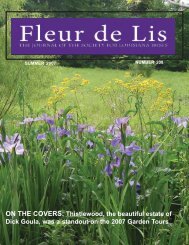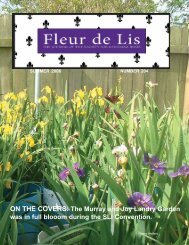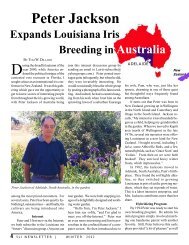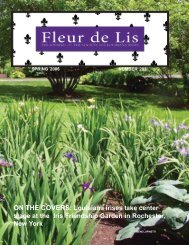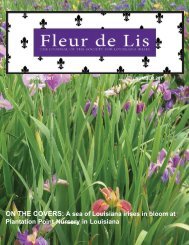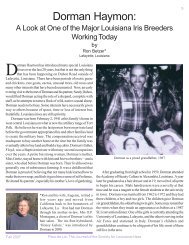The Irises of Florida - Society for Louisiana Iris
The Irises of Florida - Society for Louisiana Iris
The Irises of Florida - Society for Louisiana Iris
Create successful ePaper yourself
Turn your PDF publications into a flip-book with our unique Google optimized e-Paper software.
new species.From what Michael has found, Iwould conclude that the majority <strong>of</strong> irisesin <strong>Florida</strong> should be classed as a hybridswarm. Small reported hexagona growingin the northern part <strong>of</strong> <strong>Florida</strong>, but tohave the hybrid swarm there must besomething <strong>for</strong> hexagona to hybridizewith, if it is indeed one <strong>of</strong> the parents.Anyway you want to look at it, it seemsvery unlikely that any <strong>of</strong> the speciesgrowing in <strong>Louisiana</strong> is the other parent,so that means there is at least one otherspecies growing in <strong>Florida</strong> that has neverbeen recognized, possibly one that Smalldescribed and named.Michael Gideon has been trying tointerest some others in making the samekind <strong>of</strong> test on the <strong>Florida</strong> irises thatMichael Arnold and Bobby Bennett madeon the irises in <strong>Louisiana</strong>. Hopefully,those ef<strong>for</strong>ts will prove successful andnew scientific evidence will become availableabout <strong>Florida</strong> irises.Editor’s Note: Michael Gideon makesno claims as to the species status <strong>of</strong>irises. He has worked to encouragescientific testing, and hopefully resultswill be available soon.A View from the 1930s<strong>The</strong> Distribution <strong>of</strong> <strong>Iris</strong>in <strong>Florida</strong>BY H. HAROLD HUME<strong>The</strong> seven species <strong>of</strong> iris native in<strong>Florida</strong>, as classified by John K.Small, fall naturally into fourgroups represented by (1) <strong>Iris</strong> hexagonaWalt., (2) I. savannarum Small, I.rivularis Small, I. albispiritus Small, I.Kimballiae Small, (3) I. virginica L.and (4) I. tripetala Walt. Of these, thefour constituting the second group arenot known to occur outside the state,excepting I. rivularis, reported fromGeorgia close to the <strong>Florida</strong> boundary,while those representing the other threegroups are found far outside <strong>Florida</strong>.Within the state the native species arewidely distributed. I. savannarum is themost abundant and in some sections occursin great colonies while I. hexagonaand I. virginica are found in fair sizedcolonies in a few localities.<strong>The</strong> remaining four speciesare quite limited both innumbers and in distribution.All are moisture and humusloving plants but, althoughwater is essential totheir distribution and the establishment<strong>of</strong> young plants,yet it is not always presentin surplus throughout theyear. Often iris plants arein shallow standing watercontinuously <strong>for</strong> weeks ormonths, but at other seasonsthere is no standing waterwhere they grow. Water inoptimum or in large amountsis most beneficial duringtheir growing season. It isan interesting fact that all <strong>of</strong>them adapt themselves toordinary garden conditionsand can be grown successfullyif particular attention is given to watering,indicating that the abundance <strong>of</strong>water so <strong>of</strong>ten present where they grownaturally, although not inimical to, is actuallynot necessary <strong>for</strong> the welfare <strong>of</strong>established plants.Presumably either the irises nowgrowing in <strong>Florida</strong> came from regionsfarther north or their progenitors did.Some, as I. hexagona, I. virginica andI. tripetala, still have their northern connections.Since their seeds are commonlywater borne, they came in on the floodwaters <strong>of</strong> long ago, moving from northto south, even as they may be brought instill from time to time on the floods <strong>of</strong>the rivers that originate to the northwardand flow through western <strong>Florida</strong>. Undernatural conditions they grow in locationswhere moisture below the groundsurface, and at times above, is suited totheir needs. Since they require amplesupplies <strong>of</strong> water at certain seasons <strong>of</strong>the year <strong>for</strong> their well being, conditionsbest suited to their growth are found inthe coastal plains areas, along streamsand rivers, more particularly the St.Marys and St. Johns, and in the southernand western parts <strong>of</strong> the state wherethe land falls away south and west fromthe interior highlands. Seventy-five feetDr. H. Harold Hume was a prominenthorticultural author and anagriculture dean, provost <strong>for</strong> agricultureand acting president at theUniversity <strong>of</strong> <strong>Florida</strong> over the period1930 to 1949. This article is reprintedfrom the AIS Bulletin No. 47, April1933. With the exception <strong>of</strong> I. hexagonaand I. virginica , none <strong>of</strong> thespecies mentioned by Hume are anylonger recognized.S P R I N G 2 0 0 3 | S L I N E W S L E T T E R 7
or thereabouts is the maximum elevationand by far the greatest numbers <strong>of</strong> plantsare found at elevations only a few feetabove sea-level. Among the highestpoints at which colonies <strong>of</strong> iris grow arethe ones east <strong>of</strong> Chipley (I. virginica),south <strong>of</strong> Leesburg and north <strong>of</strong> NewnansLake (I. savannarum).<strong>The</strong> absence <strong>of</strong> irises from certainareas may be accounted <strong>for</strong> in part onthe basis <strong>of</strong> soil reactions. <strong>The</strong>y willflourish on soils that are quite acid, but itis equally true that apparently they alsogrow well on soils that are neutral or evenalkaline in their reaction. Still it is undoubtedlya fact that soils may be so alkalineas to interfere with or check theirgrowth. This may explain why they donot occur on the lower east coast <strong>of</strong> thestate, <strong>for</strong> there none apparently are to befound much south <strong>of</strong> the Fort Pierce-Okechobee line, even though soils unquestionablyadapted to their growth areto be found much farther south. Hence,while soil reaction may be to some extenta controlling factor in their distributionand may account <strong>for</strong> the presenceor absence <strong>of</strong> plants in given areas, it isapparently not the only one and it is entirelypossible that what took place affectingtheir distribution during geologicages accounts <strong>for</strong> their absence from certainlocalities. Naturally, one would thinkthat the Everglades would be adapted totheir growth, yet none are found nativein the Everglades proper. It may be thatthe general trend <strong>of</strong> drainage waters didnot distribute them in that area. Certainmineral elements necessary <strong>for</strong> theirgrowth may be absent from Evergladesoils, and again they may have beencrowded out by the rank growth <strong>of</strong> otherplants. <strong><strong>Iris</strong>es</strong> native in <strong>Louisiana</strong> andthose from other parts <strong>of</strong> <strong>Florida</strong> howeverare being grown successfully undercultivation when provided with mineralsupplements.<strong>Iris</strong> albispiritus. <strong>The</strong> northern limit<strong>of</strong> this <strong>for</strong>m appears to be on the oldLakeland-Auburndale road at telephonepole 276, about four miles east <strong>of</strong> Lakeland.It is associated with willow andcypress on the north side <strong>of</strong> the road.<strong>The</strong> type locality is near LaBelle. It isfound in the LaBelle-Fort Myers area,on the west side <strong>of</strong> Lake Okeechobeeand west <strong>of</strong> Wauchula. Over this generalarea it is widely scattered, but notabundant in any one place. Usually it ismixed with I. savannarum and perhapssome times difficult to distinguish fromthe albino <strong>for</strong>m <strong>of</strong> that species. Whiteirises probably belonging here have beenfound at Red Level, but whether theyare Albispiritus or only an albino <strong>of</strong> I.savannarum is not known. Further studyand exploration is needed <strong>for</strong> this species.<strong>Iris</strong> hexagona is confined to thenorthern portion <strong>of</strong> the state and apparentlyis not present south <strong>of</strong> a line drawnfrom Jacksonville to the mouth <strong>of</strong> theSuwannee. <strong>The</strong>re is a small colony inCallahan, another small one a few mileswest <strong>of</strong> Jacksonville near Hart HavenonState Road No. 1, and a larger one south<strong>of</strong> Magville on State Road No. 13. It isprobable that there are others in the HartHaven-Maxville area. On the west side<strong>of</strong> the upper part <strong>of</strong> the peninsula, it is tobe found in limited numbers at Cross Cityfrom whence it extends northward intoLaFayette County and westward towardPerry and St. Marks. It is in this generalarea that it is to be found in greatest abundanceand in some localities there arelarge colonies. Compared with I.virginica and I. savannarum its range isquite limited.<strong>Iris</strong> Kimballiae. Although reportedby Small 1 as occurring on both sides <strong>of</strong>the upper peninsula, this species has beenseen only at Appalachicola. As comparedwith I. savannarum, to which it is doubtlessrelated, it is a less robust plant withsmaller flowers and erect rapier-likeleaves. North <strong>of</strong> the town the SheipLumber Manufacturing Plant is located.Near it a little creek or stream comes infrom the west to join the AppalachicolaRiver on which the plant is situated. Thisstream is crossed by a bridge <strong>for</strong> the railroad.Right at the south end <strong>of</strong> the bridgeon the east side there is a small colony<strong>of</strong> I. Kimballiae. It is associated with I.virginica, willows, sawgrass, lizard’s tail“<strong>Iris</strong> albirispitus”, scanned from a copy <strong>of</strong> the Hume article thatappeared in the AIS Bulletin in 1933.and buttonbush. Across the bridge (onthe north side), it occurs among sawgrasson the west side <strong>of</strong> the track. On theeast side a short path leads from the railroadto a boat cache inside a fenced area.Just after crossing the fence, close to theedge <strong>of</strong> the stream, I. Kimballiae growsin St. Augustine grass and it is also foundnearer the boats. Farther out away fromthe bridge there is a small patch on the8 S L I N E W S L E T T E R | S P R I N G 2 0 0 3
east side <strong>of</strong> the railroad track. In thelumber yard there are a few clumps betweenthe westernmost lumber piles andthe wooded area that separates them fromthe railroad. Farther south, too, wherethere is a lot <strong>of</strong> I. virginica there are oneor two clumps. <strong>The</strong> tallest flower stemmeasured <strong>for</strong>ty inches. Here and thereplants were in bloom when the locationwas visited (March 11, 1932). Had itnot been <strong>for</strong> the frost <strong>of</strong> the previousnight (March 10), which injured manyflowers there would have been quite ashowing.<strong>Iris</strong> rivularis has been reported onlyfrom the general type locality in northeastern<strong>Florida</strong> and the writer has not beenable to collect it although three attemptshave been made. Small, 2 who describedand named it as a new species, statesthat it occurs along streams flowing intothe St. Marys River, but whether it occurselsewhere than in the watershed <strong>of</strong>that river as it approaches its outlet isnot known. <strong>The</strong>re is every reason tobelieve it is quite local in distribution, butuntil additional collections are made itsarea cannot be delimited.<strong>Iris</strong> savannarum. <strong>The</strong>re are moreplants <strong>of</strong> I. savannarum in <strong>Florida</strong> than<strong>of</strong> all other irises counted together. Italso occurs more or less abundantly overa greater area in the state than any otherspecies. It is found from the St. JohnsRiver, where it turns eastward to the sea,south to Fort Pierce and Okeechobee onthe eastern side <strong>of</strong> the state, and on thewestern side from the southern watershed<strong>of</strong> the Suwannee to the Big Cypresssoutheast <strong>of</strong> Fort Myers. Its distributionthroughout these areas is, <strong>of</strong>course, not continuous. In the centralportion <strong>of</strong> the state the northernmostpoint at which it has been found is almostnorth <strong>of</strong> Newnans Lake on theshort road from Gainesville to OrangeHeights. South <strong>of</strong> a line that may bedrawn from the Suwannee to the St.Johns through the point just mentioned,I. savannarum is to be found here andthere in comparatively small colonies inmany different places. In the northernsection it is not abundant, though thereare fairly large colonies in the vicinity <strong>of</strong>Otter Creek, but the great area in whichI. savannarum occurs in countless numbersextends around the north side <strong>of</strong>Lake Okeechobee, southward around thewest side and southwestward to LaBelleand Fort Myers. In that vast area, whichextends from Wauchula westward toBradenton and southward, it is to befound growing in colonies <strong>of</strong> many, manyacres, while in the Okeechobee prairiesection it is so abundant that one maylook out across patches <strong>of</strong> I. savannarum<strong>of</strong> such size that their farthest sides canscarcely be seen. When in bloom thesecolonies area wonderful sight. <strong>The</strong>re aregoodly sized areas on State Roads Numbers22 and 24 where they approach theimmediate vicinity <strong>of</strong> the St. Johns River.Definite locations at which it has beencollected are almost too numerous to list.<strong>Iris</strong> tripetala. Apparently, I. tripetalais found in <strong>Florida</strong> only west. <strong>of</strong> theAppalachicola River in the flatwoods inproximity to the Gulf <strong>of</strong> Mexico. Here,too, a lovely white <strong>for</strong>m is occasionallyfound. <strong>The</strong> exact area <strong>for</strong> this specieshas not been determined, but it has beencollected north <strong>of</strong> Appalachicola, west <strong>of</strong>Wewahitchka and north <strong>of</strong> St. AndrewsBay. A careful survey <strong>of</strong> the area west<strong>of</strong> the latter point will probably result inextending its known area <strong>of</strong> distribution.It is a month to six weeks later in floweringthan I. Kimballiae. Its usual bloomingseason begins about April 15th.<strong>Iris</strong> virginica is peculiarly an iris <strong>of</strong>the watersheds <strong>of</strong> the St. Marys and St.Johns Rivers. It is found here and therealong the banks <strong>of</strong> both. Usually it occursin rather small colonies and nowheredoes it cover great areas. <strong>The</strong> placeswhere it is found in greatest numbers arealong the Seaboard Air Line and the AtlanticCoast Line railroads north andnortheastward from Callahan and alongthe <strong>Florida</strong> East Coast railroad fromBayard toward St. Augustine and west<strong>of</strong> St. Augustine toward the St. JohnsRiver. It is not known to occur in peninsular<strong>Florida</strong> along the Gulf <strong>of</strong> Mexico,and it has not been found in the centralportion <strong>of</strong> the state. It is present in afew places in western <strong>Florida</strong>, more particularlyat the estuaries <strong>of</strong> several riversthat, having their origin outside the statein areas to the northward, flow through<strong>Florida</strong> into the Gulf <strong>of</strong> Mexico. For themost part it is not found along State RoadNo. 1 in western <strong>Florida</strong>, only one smallcolony having been noted east <strong>of</strong> Chipley.It grows on the Ochlockonee River wherethe road from East Port (State Road No.10) crosses it. <strong>The</strong> southernmost locationas reported by Small 3 is in the BigCypress, southeast <strong>of</strong> Fort Myers. Asthis is an isolated patch, having no connectionwith any other to the northward,its presence there may be due to seedscarried by waterfowl or other birds. Localities<strong>for</strong> the species checked by thewriter are: Black Creek, Green CoveSprings, Dun’s Creek and Rice Creek atthe St. Johns River, Ortega, Jacksonville(Willow Branch), Orange Park, Bayard,West Tocoi, Hastings, Palatka,Kingsland, Chipley, south <strong>of</strong> Glen St.Mary on the south prong <strong>of</strong> the St.Marys, Appalachicola, OchlockoneeRiver (near mouth). It has also been reportedfrom Lake City.<strong>Iris</strong> coloniesIn so many instances the iris species<strong>of</strong> <strong>Florida</strong> grow in unmixed pure groupsthat the occurrence <strong>of</strong> more than onespecies in a group or colony or even inclose proximity is always interesting.Combinations, however are found attimes. I. virginica and I. Kimballiaeare to be found both together and in closeproximity at Appalachicola. In one largecolony <strong>of</strong> I. virginica near the SheipLumber Manufacturing Plant a singleclump <strong>of</strong> I. Kimballiae has been noted.In the railroad ditch the two were closetogether and near the lumber piles (betweenthem and the railroad) they alsooccupy the same area. In this latter caseI. virginica was numerous with only afew clumps <strong>of</strong> I. Kimballiae visible hereand there.At the edge <strong>of</strong> Green Cove Springson the road from Shands Bridge, theground is low and the ditches filled witha growth <strong>of</strong> such plants as crinum, sedges,lizard’s tail, peltandra and iris. Here bothI. virginica and I. savannarum occur inclose proximity. In some cases the plantsare intermixed.S P R I N G 2 0 0 3 | S L I N E W S L E T T E R 9
I. hexagonaAn <strong>Iris</strong> hexagona specimen from the Carolinas showing the <strong>for</strong>m typicallyassociated with the species. It is blue but shorter than I. giganticaerulea.<strong>The</strong> falls appear rounded, an effect created because the hafts, the portionbeneath the style arms, are very narrow.At the north end <strong>of</strong> the bridge acrossDoctor’s Inlet, I. virginica and I.savannarum grow together; the coloniesare so mixed that care has to be taken insecuring plants <strong>of</strong> the two species separately.On the road from Jacksonville toSt. Augustine there occurs an interestingdivision <strong>of</strong> locations <strong>of</strong> species. Abouttwenty-five miles from the ferry in SouthJacksonville the highway crosses a ridge<strong>of</strong> higher land. It is about two miles wideand on either side <strong>of</strong> it the land is low.North <strong>of</strong> this ridge in the railroad ditches,I. virginica alone is found. South <strong>of</strong> theridge it is replaced by I. savannarum. OnState Road No. 48 (St. Augustine toShands Bridge) about three miles west<strong>of</strong> St. Augustine, I. virginica and I.savannarum grow in the same generalarea. <strong>The</strong>re is quite a large patch <strong>of</strong> thelatter growing with willows at the beginning<strong>of</strong> the low lands.At the east end <strong>of</strong> Shands Bridge onthe north side in the flood area <strong>of</strong> the St.Johns there is a single little group <strong>of</strong> <strong>Iris</strong>savannarum. At the west end <strong>of</strong> thebridge <strong>Iris</strong> virginica only is found (onboth sides <strong>of</strong> the road). <strong>The</strong> little groupon the south side produces dark colored,delightfully sweet-scented flowers. <strong>The</strong>sescented blooms are rare, according to thewriter’s observations.I. albispiritus is usually associatedwith or adjacent to I. savannarum whereverfound in the great iris areas <strong>of</strong> South<strong>Florida</strong> from Lake Okeechobee toLaBelle and from Wauchula to Bradenton.Since there is an albino <strong>for</strong>m <strong>of</strong> thelatter, I. albispiritus is not easy to differentiate.Notes1Addisonia. 9: 59-60. pl. 318. D:1924.2Addisonia. 12: 11-12. Pl. 390.Mar. 1927.3Journal <strong>of</strong> the New York BotanicalGarden, 32: p. 62. 1931.Right: <strong>The</strong> plates at right and onpage 13 are reproduced from the<strong>Society</strong>’s Fiftieth AnniversaryPublication, 1999. <strong>The</strong>se plateswere originally published inAddisonia in 1925-29 to illustratethe research <strong>of</strong> Dr. John K. Small,Curator <strong>of</strong> the New York BotanicalGarden, in <strong>Florida</strong>, <strong>Louisiana</strong> andother areas.“I. savanarum”“I. Kimballiae”10 S L I N E W S L E T T E R | S P R I N G 2 0 0 3
Discovering New Forms among the HexanonaeLooking Hard in <strong>Florida</strong>With almost all the <strong>for</strong>mer“species” now rejectedand I. hexagona ascendant,what are we to make<strong>of</strong> the variety among<strong>Florida</strong>’s native irises?BY PATRICK O’CONNORWhat we do not yet know, or isnot documented, about thenative irises <strong>of</strong> <strong>Florida</strong> apparentlycould fill volumes. <strong>The</strong> principalspecies attributed to peninsular <strong>Florida</strong>,I. hexagona, is believed by some to havecompany, and it is pretty clear regardlessthat the variety among the irises inthe Series Hexagonae found in <strong>Florida</strong>far exceeds previous description.I am singularly unqualified to <strong>of</strong>feropinions on these irises, having no firsthandknowledge <strong>of</strong> them. I certainly amnot prepared to deal with whether thereare more species out there than those thathave been designated; or fewer, with theexceptional <strong>for</strong>ms simply representingintraspecies variation. It seems thatsomeone always wants to tinker withspecies designations, and why not?<strong>The</strong>y are manmade categories useful tothe degree that they encapsulate but donot obscure important characteristics.Bruce Hanson, Curator <strong>of</strong> the Herbariumin the Department <strong>of</strong> Biology atthe University <strong>of</strong> South <strong>Florida</strong> at Tampa,cautions that “true that species vary withhabitat, with geography, with microclimaticconditions, et cetera. And in myopinion, horticultural hobbyists seem alwaysto make too much <strong>of</strong> minor differencesin color and stature.”<strong>The</strong> widely accepted view today,unlike in the time <strong>of</strong> Small or Hume, isthat the indigenous hexagonae in <strong>Florida</strong>are limited to two or perhaps three species.I. brevicaulis has exceedingly limiteddistribution and is reported only fromJackson County, which abuts Georgia.I. fulva is reported only in Santa RosaCounty, also in the panhandle and only acounty away from Alabama. One sourceasserts that fulva actually was introducedto the state. <strong>The</strong> irises in the rest <strong>of</strong> the<strong>Florida</strong>, from the Georgia border to thesouthern tip, are I. hexagona. BruceHanson indicates that, barring taxonomicresearch to the contrary, I. hexagona willcontinue to be the designation <strong>of</strong> the<strong>Florida</strong> irises.High Ground in <strong>Florida</strong><strong>The</strong> center <strong>of</strong> the Peninsular<strong>Florida</strong>, roughly inside the rectangle,is marked by a centralridge that tapers <strong>of</strong>f toward thecoast. <strong>The</strong>se southern highlandsrepresent one <strong>of</strong> the threeenvironments associated withvariation in iris <strong>for</strong>ms.But WaitFair enough. But consider the workand observations <strong>of</strong> Michael Gideon andhis family.Michael Gideon lives in South<strong>Florida</strong>. He is has devoted as much timeand ef<strong>for</strong>t to the recognition and understanding<strong>of</strong> the <strong>Florida</strong> irises as any <strong>of</strong>the early collectors did with respect to<strong>Louisiana</strong>’s irises during the discoverydays from the 1930s to the 1950s. Overseveral years, Michael and his family havesystematically sought out the locations<strong>of</strong> native irises, collected samples, andobserved them in garden culture. Basedon the unexpected variety found, he has<strong>The</strong> relief map was developed by Ray Sterner <strong>of</strong> the Johns HopkinsUniversity Applied Physics Laboratory and used with permission.Additional in<strong>for</strong>mation is available at http://fermi.jhuapl.edu/states/.S P R I N G 2 0 0 3 | S L I N E W S L E T T E R 11
From top: A pale violet from LevyCounty; two views <strong>of</strong> a nice, veinedpurple collected by the Vestrands.Photos by Steve Shepard.developed fascinating hypotheses aboutthese irises, their ecological niche, whatthey represent and where they camefrom. His discoveries should stimulatefurther interest by Floridians in their irislegacy, and they should engender a fullerappreciation by all <strong>for</strong> the scale and scope<strong>of</strong> the hexagonae.I cannot pretend to do justice to thedetail <strong>of</strong> Michael’s observations, researchand hypothesizing, which I have cometo generally understand through a number<strong>of</strong> letters and phone conversations.Hopefully, knowledge <strong>of</strong> what has beendiscovered so far will stimulate futurework, including taxonomic analysis, tounderstand and appreciate these overlookedplants.GeographyMichael Gideon has observed threedifferent habitats in <strong>Florida</strong> that broadlycorrespond to variations in irises. <strong>The</strong>first is based on a north-south dimension.<strong>Florida</strong> is an elongated state stretching447 miles from the St. Marys Riverto Key West.Variation in climate as well as topographyover this distance is associated withsignificant differences in iris bloom time.This creates separate niches in whichirises have developed independently.Michael places the border <strong>of</strong> this northsouthdivision at “an imaginary line runningfrom Cross City in the west throughGainesville and east to Palataka.” Hesays, “<strong>The</strong>re’s a weather difference atthis line with six weeks earlier winter andsix weeks later spring. This keeps thesouthern <strong>for</strong>ms in the south.”Above the line grow the “northern<strong>for</strong>ms”, which are generally the same asthe irises found in Georgia. I gather thatthese are more typical <strong>of</strong> the original I.hexagona, named from specimens collected,I believe, from the Carolinas.Within the southern region <strong>of</strong> peninsular<strong>Florida</strong>, and below the Cross Cityto-Palatakaline, there is an additional divisionbased on elevation and characteristicsassociated with highland versuscoastal terrain. Not having firsthand familiaritywith <strong>Florida</strong>, the notion <strong>of</strong> highlandscame as a surprise, but the reliefmap on the previous page clearly reflectsthe central ridge.Distinct differences have been observedbetween highland and coastalirises, and both differ from the northern<strong>for</strong>ms. <strong>The</strong> highland <strong>for</strong>ms are most interestingbecause they have been largelyoverlooked. Michael Gideon describesthe highland habitat in this way:“In many locations in the interiorit’s almost desert like, the soil ispure silica sand and the sun burns<strong>of</strong>f the surface moisture. One wouldnever imagine iris growing hereand that’s why no one ever lookedin the highlands. At some pointthe rainwater seeps out downslope.This is where the highland <strong>for</strong>m exists.<strong>The</strong>se seeps are usually notconnected to any river and are landlocked.You must learn where tolook. Usually, it’s a good hike into these isolated bogs . . . .”He also observes that these sites <strong>of</strong>tenare on private cattle land. Many acresnot devoted to cattle have been trans<strong>for</strong>medby the phosphate industry into alandscape inhospitable to irises. Cattlemenactually have protected these irisesfrom destruction.<strong>The</strong> highland <strong>for</strong>ms are <strong>of</strong>ten white,but not always. Blues, purples and othercolor variants with the characteristics <strong>of</strong>highland irises are also found. <strong>The</strong>seirises are shorter than the coastal <strong>for</strong>ms,never taller than three feet, and with aflower smaller than the coastal irises,more on the order <strong>of</strong> I. fulva in size. <strong>The</strong>flower is spidery and the petals recurve,although exceptions are found. Interestingly,the highland <strong>for</strong>m is not fond <strong>of</strong>over-wet situations. Perhaps it resemblesI. brevicaulis in this trait.<strong>The</strong> coastal irises have been describedas “giant blues,” a phrase familiarin South <strong>Louisiana</strong>. <strong>The</strong> northern<strong>for</strong>ms are also generally blue but shorter,and they sound like the originally describedI. hexagona.Michael sent me a large number <strong>of</strong>plants several years ago. Only two havebloomed, both blues that show no apparentdifference from I. giganticaerulea.<strong>The</strong>y were tall and robust. One was acoastal <strong>for</strong>m from near Sarasota notable<strong>for</strong> its vigor and the monstrous rhizomesit produces. <strong>The</strong>y match those <strong>of</strong> somegiganticaeruleas that I once dug out <strong>of</strong> afreshwater marsh in Cameron Parish,<strong>Louisiana</strong>, each very stout and easily afoot or more in length.Other plants sent from the highlands,and the northern <strong>for</strong>ms, do not grownearly that vigorously or produce suchprodigious rhizomes, even while growing<strong>for</strong> me in identical garden conditions.12 S L I N E W S L E T T E R | S P R I N G 2 0 0 3
“I. albispiritus”, named by Small.Compare to ‘Cass White’, right.Except <strong>for</strong> the coastal <strong>for</strong>ms, which thrivein the New Orleans area, the irises thatMichael sent so far have not bloomed.<strong>The</strong>y do survive, however.Apparently some <strong>of</strong> the <strong>Florida</strong> irisesare better adapted to the particular climateand soil <strong>of</strong> their niches in <strong>Florida</strong>than to the rest <strong>of</strong> the Gulf Coast. Or,perhaps my mistake was not knowing howto accommodate their origins. <strong>The</strong>yprobably deserve better treatment than Ihave af<strong>for</strong>ded them.Overlap and Variation<strong>The</strong> observation <strong>of</strong> three generallydistinct habitats should not imply that all<strong>Florida</strong> hexagonae fall clearly into oneA “giant blue” from near Sarasota growing in a NewOrleans garden.grouping or another. In fact, one<strong>of</strong> the major observations made isthat there is unexpected variationamong the <strong>Florida</strong> irises thatseems to extend well beyond threegroupings.Part <strong>of</strong> the reason <strong>for</strong> variationis that in places where the differentenvironments intersect, aswith the natural hybrids found in<strong>Louisiana</strong>, intermediate <strong>for</strong>ms areproduced. And, since seeds floatdownward (barring the effects <strong>of</strong>hurricanes), there is a tendency <strong>for</strong>some <strong>of</strong> the characteristics <strong>of</strong> thehighland irises to drift downwardalso, so that there is a mix in theadjoining areas. <strong>The</strong> reverse doesnot generally occur since waterand seed are not inclined to flowupstream unless pushed. Michaeladds that, “Even now the riversthat drain out <strong>of</strong> the highlands usuallygo dry and that’s what keepsthe coastal <strong>for</strong>ms out <strong>of</strong> the highlands.”In areas where plants with both highlandand coastal characteristics are found,it was observed that the highland <strong>for</strong>mstended to be up on a levee, the coastalsdown in the water.Another conditioning factor promotingvariation is isolation. Many highlandbogs are isolated from one anotherwith little chance <strong>of</strong> cross contamination.That being the case, the irises in one areaare free to interbreed over the years,many hundreds <strong>of</strong>them, and to developunique and stablecharacteristics. This isnot unlike what mayhave happened in<strong>Louisiana</strong> aroundAbbeville, where I.nelsonii developed,the product originally<strong>of</strong> other species.It should not besurprising that, withtime, a localizedpopulation could developunique characteristics.<strong>The</strong> work <strong>of</strong>‘Cass White’ , collected by KennethCass in 1985 in Lee County in the samearea where Dr. John Small collectedspecimens from which “I. albispiritus”was named. ‘Cass White’ wasregistered by Robert Turley in 1996.hybridizers has vividly demonstrated howmuch change in plant characteristics ispossible very quickly through controlledcrosses, so different characteristics mightwell pop up and then come to dominatean isolated population left alone to interbreedover a long period.Michael feels that Small’s white “I.albispiritus” is a cross between highlandand coastal <strong>for</strong>ms. Once thought to havedisappeared, he rediscovered the socalled“Ghost <strong>Iris</strong>” after deciding to lookinland and upland. He has now found itin numerous locations, but in wetter sitesthan the habitat <strong>of</strong> a pure highland <strong>for</strong>m.Michael cites the collected and registered‘Cass White’ as an example <strong>of</strong>“I. albispiritus.” It was, in fact, collectedby Kenneth Cass in 1985 at thesite were Small found “albispiritus.”ColorsOne <strong>of</strong> the principal variations foundis the existence <strong>of</strong> irises other than theblues and whites associated with I. hexagona.In a letter a couple <strong>of</strong> years ago,Michael reported yellows, reds, and othercolors, and added, “<strong>The</strong> yellows andreds are only found in the highland <strong>for</strong>m.S P R I N G 2 0 0 3 | S L I N E W S L E T T E R 13
Left, from top: spidery blue coastal<strong>for</strong>m from near Sarasota; I. hexagonasample under study by Alan Meerow;a pale violet from Hillsboroughcounty; and a deep purple from PolkCounty, showing the recurvatureassociated with the highlands <strong>for</strong>m.Middle, from top: a Highlands Countyburgundy-violet; a Manatee Countywhite; another white collected west <strong>of</strong>Palataka; and a very short I.hexagona, around two feet;Right, from top: a violet northern<strong>for</strong>m from the Pinhook Swamp; a PolkCounty blue-purple.<strong>The</strong> interior folks all speak <strong>of</strong> a brightyellow. So far we’ve found pale yellowsand the opaque yellow with a violetflush. Kenneth Cass found a real nicebicolor last spring.” Apparently, many<strong>of</strong> the whites found in <strong>Florida</strong> are actuallymore <strong>of</strong> a cream color, which suggeststhe presence <strong>of</strong> yellow. More recently,Michael indicated that the brightyellow has now been found.<strong>The</strong> photographic evidence is interesting,although Michael has not had thetime to emphasize creation <strong>of</strong> perfect pictures.His photography has been motivatedby the need to create a record <strong>for</strong>himself <strong>of</strong> what he has found rather thancreating sharp images <strong>of</strong> single blossoms.I have seen quite a few <strong>of</strong> the pictures,and indeed there is a surprising degree<strong>of</strong> color variation. And, they supplyclear documentation <strong>of</strong> the observed14 S L I N E W S L E T T E R | S P R I N G 2 0 0 3
differences in flower <strong>for</strong>m. Other photos<strong>of</strong> <strong>Florida</strong> irises by Steve Shepardadd supporting evidence.My understanding is that the “reds”found in <strong>Florida</strong> are not on the order <strong>of</strong>I. fulva or I. nelsonii. Occasionally aniris has been found with a distinct reddishinfluence, but it would be incorrectto say that they are comparable to thetwo indisputably red species.It is difficult to grasp and characterizedifferences in <strong>Florida</strong> irises in terms<strong>of</strong> color. My appreciation <strong>of</strong> it is thatthere are unexpected color variations, althoughnot in great numbers. White is apredominant color in some localities, butthat has been reported (and it is an interestingdifference from <strong>Louisiana</strong> wherewhites are only occasional finds).At least in comparison to <strong>Louisiana</strong>,the apparent absence <strong>of</strong> I. fulva in <strong>Florida</strong>appears to have suppressed the colorrange <strong>of</strong> “hybrid” <strong>for</strong>ms found there.Fulva contributes both red and yellow tohybrid crosses. Still, interesting and unanticipatedvariety exists with the veryreal possibility that a full appreciation <strong>of</strong><strong>Florida</strong>’s irises would reveal complexitiesin their backgrounds and relationshipsthat we do not now understand.OriginsMichael Gideon not only searches outnative irises, but he has thought aboutthem broadly and <strong>of</strong>ten in epochal terms.I am unable to do justice to these themes.He <strong>of</strong>ten refers to what <strong>Florida</strong> and theGulf Coast were like be<strong>for</strong>e, during, andafter the Ice Age. How the glaciers retreated,where the irises must have beendeposited and how they developed.What the relationship is between <strong>Louisiana</strong>,<strong>Florida</strong> and other places along theGulf Coast. Fascinating stuff with whichI am ill-equipped to deal.Another theme, equally fascinating,is the relationship between native irisesand the native peoples <strong>of</strong> prehistorictimes. <strong>The</strong>re is clear evidence <strong>of</strong> theuse <strong>of</strong> irises <strong>for</strong> their medicinal and otherproperties. It is plausible to entertain theidea that, to the extent that these plantswere <strong>of</strong> value in the lives <strong>of</strong> thesepeoples, they were collected and plantednear dwelling places or even traded.Indeed, the pollen record in archeologicalsites clearly shows that irises werepresent. It is well documented that tradeoccurred over wide areas, with relationshipsbetween <strong>Florida</strong>, <strong>Louisiana</strong> andother areas northward into the MississippiValley. Perhaps some variation in<strong>Florida</strong> irises resulted from the intervention<strong>of</strong> man in ancient times. I am notsure where this leads specifically in terms<strong>of</strong> our understanding <strong>of</strong> what we find today,but it is a most interesting line <strong>of</strong>inquiry.What Next?<strong>The</strong> discoveries <strong>of</strong> Michael Gideonand his family invite at least as manyquestions as they answer. Are variationsin plant growth due to local conditions?What happens when a coastal<strong>for</strong>m is grown under highland conditions,and vice versa? Dr. Alan Meerow <strong>of</strong>the USDA Agricultural Research Servicein Miami is involved in DNA testing <strong>of</strong>the <strong>Florida</strong> irises. That should help naildown relationships among <strong>Florida</strong> irisesand possibly their relationship with irisesfrom elsewhere.It is sometimes difficult to understandwhy the irises <strong>of</strong> <strong>Florida</strong> have notattracted more notice in iris circles, includingSLI. Small called our attentionto them long ago. Certainly, people livingin proximity to these plants have appreciatedthem, and not just in recenttimes. <strong>Iris</strong> distribution is widespread in<strong>Florida</strong>, even if they are not always accessible.Benny Trahan <strong>of</strong> Slidell, <strong>Louisiana</strong>,who has systematically scoured the <strong>Louisiana</strong>countryside <strong>for</strong> new and different<strong>Louisiana</strong>s still in the wild, also took atwo week vacation to search among the<strong>Florida</strong> irises. In that time, he did notfind great variation, but he was impressedthat, if anything, the numbers <strong>of</strong> plantsgrowing in <strong>Florida</strong> may easily exceedthose in <strong>Louisiana</strong>, at least what is lefttoday.With such numbers <strong>of</strong> plants outthere, spread widely over a varying climaticand topological field and <strong>of</strong>ten inaccessible,perhaps it should not be surprisingthat there is heret<strong>of</strong>ore unappreciatedvariety in the irises <strong>of</strong> <strong>Florida</strong>.Hopefully, we are approaching a timewhen they will be more widely recognizedand understood.A clump <strong>of</strong> violet Taylor County irises. Photo by Steve Shepard.S P R I N G 2 0 0 3 | S L I N E W S L E T T E R 15



